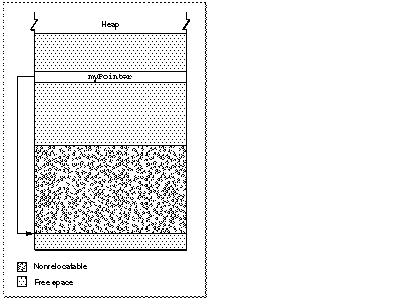
Inside Macintosh: Memory
Previous | Chapter Top | Chapter Contents | Next |
You can use the Memory Manager to allocate two different types of blocks in your heap: nonrelocatable blocks and relocatable blocks. A nonrelocatable block is a block of memory whose location in the heap is fixed. In contrast, a relocatable block is a block of memory that can be moved within the heap (perhaps during heap compaction). The Memory Manager sometimes moves relocatable blocks during memory operations so that it can use the space in the heap optimally.
The Memory Manager provides data types that reference both relocatable and nonrelocatable blocks. It also provides routines that allow you to allocate and release blocks of both types.
To reference a nonrelocatable block, you can use a pointer variable, defined by the Ptr data type.
TYPE
SignedByte = -128..127;
Ptr = ^SignedByte;
A pointer is simply the address of an arbitrary byte in memory, and a pointer to a nonrelocatable block of memory is simply the address of the first byte in the block, as illustrated in Figure 1-8 . After you allocate a nonrelocatable block, you can make copies of the pointer variable. Because a pointer is the address of a block of memory that cannot be moved, all copies of the pointer correctly reference the block as long as you don't dispose of it.
Figure 8 A pointer to a nonrelocatable block

The pointer variable itself occupies 4 bytes of space in your application partition. Often the pointer variable is a global variable and is therefore contained in your application's A5 world. But the pointer can also be allocated on the stack or in the heap itself.
To reference relocatable blocks, the Memory Manager uses a scheme known as double indirection. The Memory Manager keeps track of a relocatable block internally with a master pointer, which itself is part of a nonrelocatable master pointer block in your application heap and can never move.
The Memory Manager allocates one master pointer block (containing 64 master pointers) for your application at launch time, and you can call the MoreMasters procedure to request that additional master pointer blocks be allocated. See "Setting Up the Application Heap" beginning on Setting Up the Application Heap for instructions on allocating master pointer blocks.
When the Memory Manager moves a relocatable block, it updates the master pointer so that it always contains the address of the relocatable block. You reference the block with a handle, defined by the Handle data type.
TYPE
Handle = ^Ptr;
A handle contains the address of a master pointer. The left side of Figure 1-9 shows a handle to a relocatable block of memory located in the middle of the application heap. If necessary (perhaps to make room for another block of memory), the Memory Manager can move that block down in the heap, as shown in the right side of Figure 1-9 .
Figure 9 A handle to a relocatable block

Master pointers for relocatable objects in your heap are always allocated in your application heap. Because the blocks of masters pointers are nonrelocatable, it is best to allocate them as low in your heap as possible. You can do this by calling the MoreMasters procedure when your application starts up.
Whenever possible, you should allocate memory in relocatable blocks. This gives the Memory Manager the greatest freedom when rearranging the blocks in your application heap to create a new block of free memory. In some cases, however, you may be forced to allocate a nonrelocatable block of memory. When you call the Window Manager function NewWindow , for example, the Window Manager internally calls the NewPtr function to allocate a new nonrelocatable block in your application partition. You need to exercise care when calling Toolbox routines that allocate such blocks, lest your application heap become overly fragmented. See "Allocating Blocks of Memory" for specific guidelines on allocating nonrelocatable blocks.
Using relocatable blocks makes the Memory Manager more efficient at managing available space, but it does carry some overhead. As you have seen, the Memory Manager must allocate extra memory to hold master pointers for relocatable blocks. It groups these master pointers into nonrelocatable blocks. For large relocatable blocks, this extra space is negligible, but if you allocate many very small relocatable blocks, the cost can be considerable. For this reason, you should avoid allocating a very large number of handles to small blocks; instead, allocate a single large block and use it as an array to hold the data you need.